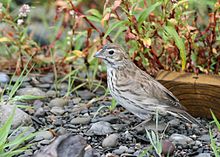Lark bunting
| Lark bunting | |
|---|---|
 |
|
| Male lark bunting | |
 |
|
| Female lark bunting | |
| Scientific classification | |
| Kingdom: | Animalia |
| Phylum: | Chordata |
| Class: | Aves |
| Order: | Passeriformes |
| Family: | Emberizidae |
| Genus: |
Calamospiza Bonaparte, 1838 |
| Species: | C. melanocorys |
| Binomial name | |
|
Calamospiza melanocorys Stejneger, 1885 |
|
| Synonyms | |
|
Fringilla bicolor J. K. Townsend, 1837 |
|
Fringilla bicolor J. K. Townsend, 1837
The lark bunting (Calamospiza melanocorys) is a medium-sized American sparrow native to central and western North America.
The lark bunting is monotypic, the only member of the genus Calamospiza, and is not closely related to any other genera. It was first described by J. K. Townsend in 1837, from a specimen collected on a trip he took with Thomas Nuttall, under the name Fringilla bicolor. This is a preoccupied name, so Leonhard Hess Stejneger renamed the species in 1885 Calamospiza melanocorys. By then, the lark bunting had already been given its own genus, the one it is still placed in, by Charles Lucien Bonaparte in 1838.
Lark buntings are small songbirds, with a short, thick, bluish bill. There is a large patch of white on the wings and they have a relatively short tail with white tips at the end of the feathers. Breeding males have an all black body with a large white patch on the upper part of the wing. Nonbreeding males and females look similar and are grayish brown with white stripes.
The lark bunting is the most prevalent of the passerine species found in the grasslands of North America. Their breeding habitat is prairie regions in central Canada and the mid-western United States. These birds migrate in flocks to winter southern Texas, Arizona and the high plateau of northern Mexico in the fall.
The birds typically nest in dispersed colonies. Males fly up over their territory and sing while descending to declare ownership of a nesting territory. The song consists of a mix of whistles and trills. The call is a soft hoo.
The nest is an open cup on the ground in a grassy area.
...
Wikipedia

